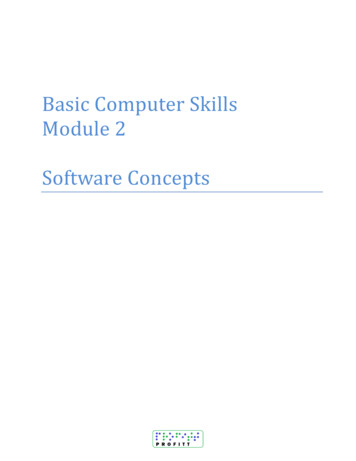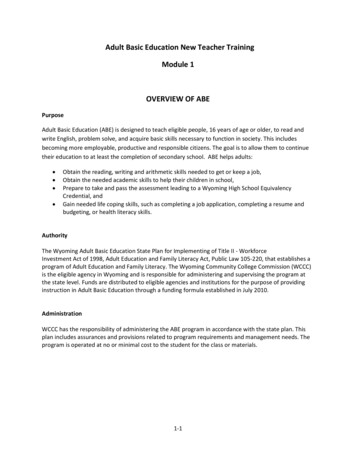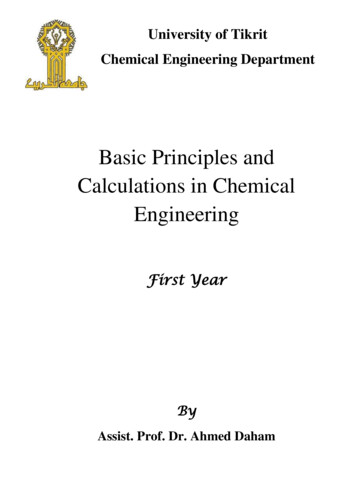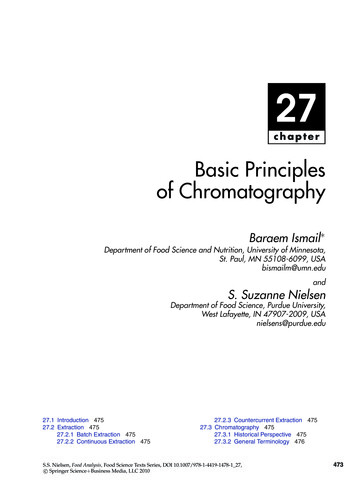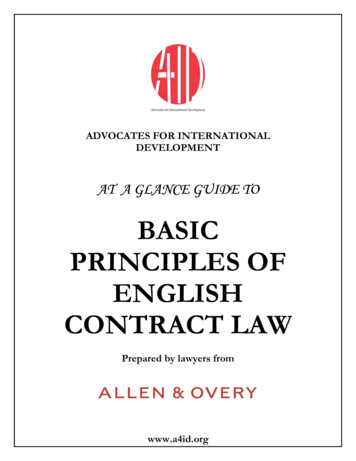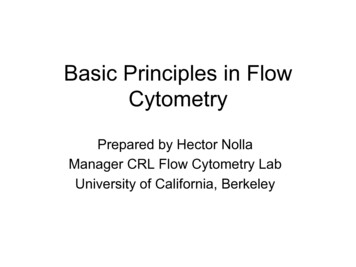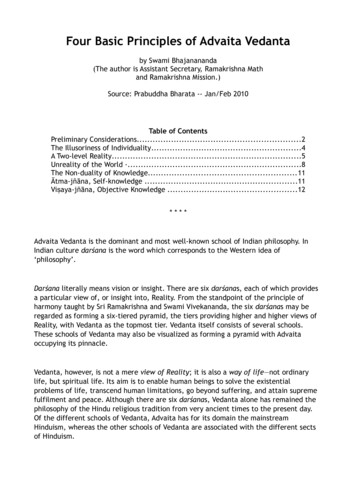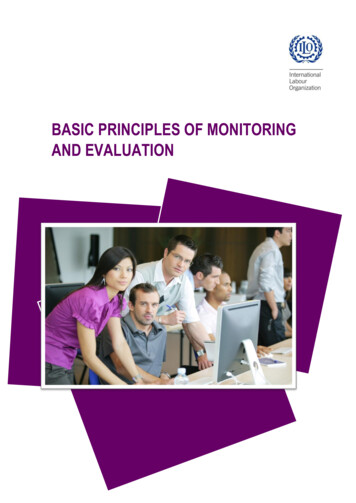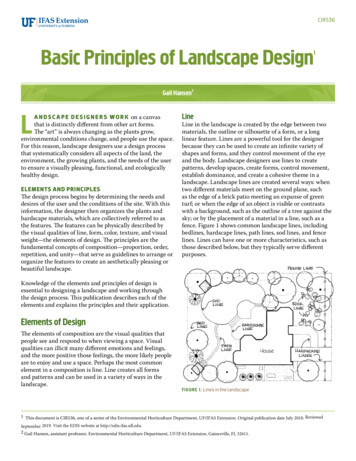
Transcription
Module 1: The Basic Principles of Income TaxationMODULE 1: THE BASIC PRINCIPLES OF INCOMETAXATIONThe central questions of this module are:íWhich forms of income are taxable?íííííWhich business expenses and operational expenses can be deducted whenreporting income?Which special personal expenses and extraordinary expenses can bededucted when reporting income?Which tax rate is to be used when?Which deductible expenses can be subtracted from the total tax burden?How is income tax levied?Tz 1Ms. Taxable is self-employed in Vienna as a tax consultant and earns in thecourse of her work as such an annual income of 60,000. She has a savingsaccount which drew 1,500 in interest last year. Furthermore, she purchasedproperty three years ago in Upper Austria, which she in turn sold this past yearfor 35,000. Last year, she paid a total of 600 in church tax. After last year’sflooding, Ms. Taxable rented industrial dryers and purchased a new washingmachine, totaling 5,000. Ms. Taxable’s husband is currently on paternity leaveand takes care of their one-year-old daughter. Over the past year, Ms. Taxablehas prepaid 11,500 of her income tax.I1Principles of income taxationThe ability-to-pay principleTz 2Income is considered to be an indicator of an individual or company’s economicperformance. Thus, one of the main principles of income taxation is that of measuring anindividual’s ability to pay, and so the Income Tax Act (ITA) regulates which types ofaccretion of wealth are deemed to be income and therefore taxable.Tz 3Income tax reflects each individual’s ability to pay. There is no joint taxation ofmarried couples or households. The ability-to-pay principle for individuals is expressed invarious ways in the Austrian tax system. The following provisions can be set as examples:íííAn amount equal to the subsistence level is tax exempt. Currently, an amount of 11,000 is tax-free (Sec. 33(1) ITA).The rate of income tax is set up progressively. Progressive taxation refers to thedisproportionate taxation of higher incomes. In other words, the higher one’s incomeis, the higher the rate at which it will be taxed.Certain provisions take into account the special financial burdens of certain groupsof taxpayers, e.g. single parents, sole wage earners, or persons with child supportobligations.7
8Introduction to Austrian Tax Law2Tz 4The principle of universalityIn determining income as an individual’s ability to pay, the geographic origin of theincome, whether domestic or foreign, is irrelevant. The Austrian income tax code is said tofollow the principle of universality, meaning that individuals are subject to unlimitedtaxation, and are therefore taxed based on their total worldwide income. Only thoseindividuals who are neither residents of nor have their habitual abode in Austria are limitedlytaxed. If this is the case, only income sourced in Austria is subject to Austrian taxation (seethe principle of territoriality).3Tz 5The principle of periodic taxationThe taxable income for the period of one calendar year serves as the basis for individualtaxation. In assessing an individual’s overall ability to pay, all income derived by a taxableperson during his lifetime would have to be considered. However, tax authorities naturallycannot wait that long for tax revenue. Accurately assessing an entire lifetime of taxes at oncewould also be almost insurmountably challenging from an administrative point of view. As aresult, the ability to pay is evaluated only periodically, namely every calendar year.Still, the taxation based on annual income can be rather arbitrary and can ultimately lead toundue hardships. If a person generates losses in one year, but earns a much higher income inthe second year, the progressive tax rate will lead to a substantially higher taxation rate thanthat of someone who has generated a constant stream of income in each of the two years. Toavoid such misleading calculations, a periodic assessment can be granted to the taxpayerunder certain circumstances. However, such a periodic compensation serves only as anexception to the principle of periodic income.II1Categories of incomeThe seven categories of incomeTz 6According to Sec. 2(2) ITA, taxable income is defined as the total amount of incomeaggregated from all seven categories of income, after the deduction of losses derived from theseveral categories, the deduction of special personal expenses (Sec. 18 ITA) and extraordinaryexpenses (Sec. 34 and 35 ITA), and after the consideration of allowable deductions from Sec.104, 105 and 106a ITA.Tz 7Sec. 2(3) lists the following seven categories of income:BusinessincomeNon-businessincome1. Income from agriculture and forestry (Sec. 21),2. Income from self-employment (Sec 22),3. Income from commercial activities (Sec. 23),4. Income from employment (Sec. 25),5. Income from capital investments (Sec. 27),6. Income from renting, leasing and royalties (Sec. 28),7. Other specific income (Sec. 29).Maincategories ofincomeAncillarycategories ofincome
Module 1: The Basic Principles of Income TaxationThe distinction between business income (from profits) and non-business income (surplusincome) is particularly relevant for tax computation. The three ancillary categories ofincome are subsidiary to the four main categories of income.2Tz 8Business income and the notion of commercial activitiesThe first three categories of income are seen as business income. The applicability of the firstthree categories of income is predicated on the existence of a business. According to Sec. 23business income is defined as income from an independent, continuous activity undertakenwith the intent to make a profit, i.e. the participation in general commerce. The AustrianHigher Administrative Court interprets these criteria in the following way:ííííIndependence exists when the taxpayer undertakes his activities at his own risk andexpense and thus is subject to business hazard. This differentiates an entrepreneurfrom an employee under tax law. A state of employment exists for tax purposes if itleads to income from employment, and if the employee sells his own manpower tothe employer (Sec. 47(2) ITA). The same notion of independence can be found inSec. 2(1) Value Added Tax Act (VwGH 7.12.1994, 91/13/0171).Continuous activity is an activity exercised professionally by using specificknowledge or skills. Moreover, an activity can be seen as continuous, if it isexercised repeatedly or with the intention of repeated exercise. If it occurs over aprolonged period of time, even in the absence of this intention to repeat, an activityis still seen as continuous (VwGH 14.9.1988, 87/13/0248; one time activity lastingfor a period of nine months).An intention to make a profit is recognized when a commercial activitycontinuously generates income in excess of its total production costs. The focus ofthe taxpayer is to make a profit which falls into one of the seven categories ofincome. To distinguish business-related losses from all non-business-related losses,the Federal Ministry of Finance has defined the term hobbies (LiebhabereiVO,BGBl 1993/33) (NB: For the purposes of this book, hobbies are to be defined asactivities not engaged in for profit.) If expenses are made for private reasons (i.e.,for the purpose of private consumption), these activities can be seen as hobbies,which are irrelevant for tax purposes.Example: A businessman (who is at the same time gourmet of wine)has worked for years as a winemaker on the weekends in Burgenland.For this reason he has acquired certain oenophilic (wine-producing)equipment, restored his wine cellar, and sometimes even employedstaff. In this context he has incurred a lot of expenses, without everturning a profit. Profits are likewise not expected in the foreseeablefuture. Thus, his activities as a winemaker can be seen as a hobbyaccording to the definition set out by the Federal Ministry of Finance.Consequently, his losses cannot be deducted for tax purposes; at thesame time, if he inadvertently generates a profit, this profit will not besubject to taxation.Participation in general commerce can be assumed when the goods sold orservices rendered are made available to the general public, even if at times the9
10Introduction to Austrian Tax Lawtaxpayer only deals with a limited number of people or a single contractor(VwGH 14.9.1988, 87/13/0248).3Tz 9The definition of the various types of incomeThe first three categories of business income and the remaining four categories of nonbusiness income can be defined in the following way:íííIncome from agriculture and forestry (Sec. 21 ITA): This category consists ofparticular forms of income from the primary sector (namely from agriculture andforestry), including livestock breeding and animal husbandry and the sale ofproducts produced therefrom, freshwater fish farming, and hunting, as well asincome generated by related activities.Income from self-employment (Sec. 22 ITA): This category comprises:o Income from scientific, artistic, literary, teaching or educationalactivitieso Professional activities such as those rendered by doctors or othermedical professionals, lawyers or legal advisors, tax accountants andadvisors, trusteeso Income arising from the administration of propertyo Income earned as a member of the supervisory board of directorso Salaries or other forms of compensation of any kind granted by acompany to majority shareholders (NB: A majority shareholder is heredefined as a person whose share equity amounts to more than 25% ofthe share capital of the company; see also income from employment)Income from commercial activities (Sec. 23 ITA): Income from commercialactivities is defined as income from trade or business which is not consideredagricultural or forestry activity, or as income from professional, freelance services(subsidiarity within the business-related categories of income).For the three types of business-income, the alienation of an enterprise(or an operating unit of an enterprise) is deemed to be a taxable event(Sec. 24 ITA). Under special circumstances this alienation of businesscan enjoy different tax privileges (Sec. 24(4) to (6) ITA and Sec. 37(2)and (5) ITA).Example: Mr. A is 65 years old and one of two equal partners of apartnership. After 10 years in business, he sells his 50% participationin the partnership to his successor, Mr. B. Up to now A had incomefrom commercial activities according to Sec. 23 no. 2. With thealienation of his ownership, A realizes a profit of 12,000, which isseen as income from commercial activities according to Sec. 23 no. 3icw Sec. 24(1)(1) ITA. The taxpayer can now consider a tax-freeexemption in the amount of 3,650 ( 7,300 * 50%). Alternatively, he
Module 1: The Basic Principles of Income Taxationcould also consider the reduction of progressive tax rate described inSec. 37 ITA.íIncome from employment (Sec. 25 and 26 ITA): This category includes:o Compensation in cash or in kind to employed persons, both monetaryand non-monetaryo Pension income received by a retiree from social security, from aprivate pension fund or from the employer itselfo Compensation of any kind granted by a company to a minorityshareholder. (A minority shareholder is a person whose share amountsto less than or equal to 25% of the share capital of the company; seealso income from independent personal services)o Compensation granted to particular political officialsIn general, income from employment is subject to wage tax which iswithheld by the employer.ííIncome from capital investments (Sec. 27 ITA): This category of incomeparticularly comprises:o Income in return for capital, e.g. profit distributions by legal entities(such as dividends), income from a typical silent partnership (mereparticipation in the continuous profits of an entrepreneur in contrast toan atypical silent partnership which comprises a share in the hiddenreserves and goodwill. Such atypical silent partnerships are treated asnormal partnerships for income tax code purposes.). Interest from bankdeposits and loans, benefits received from life insurance policies aswell as benefits granted from trusts.o Income from capital gains on investments, including capital gains onassets generating capital gains from investments (Sec. 27(3)).o Income from derivative trade (Sec. 27(4))Income from renting, leasing and royalties (Sec. 28 ITA): This category consistsof:o Income from the renting or leasing of real estateo Income from renting or leasing of conglomerations of assets, such asthose of an enterpriseo Royalties/licenses from the license to use works protected by theAustrian Federal Copyright Act, as well as royalties from theassignment of industrial property rights, patents, and know-howExamples:1. The taxpayer rents out his condominium. This activity isnot seen as commercial activity, but only as administration11
12Introduction to Austrian Tax Lawof assets. Thus, it constitutes income from renting, leasingand royalties according to Sec. 28 ITA.2. The taxpayer owns several flats in a touristy region. Forrenting the flats to tourists he regularly has to performadvertising and administrative tasks. In addition heperforms ancillary services for his guests (cleaning, servingfood and beverages). In contrast to the first example, thesevarious activities are clearly not done with the purpose ofmerely administrating the assets. The taxpayer generatesincome from commercial activities (see VwGH 13.10.1982,82/13/0125).íOther specific income (Sec. 29 to 31 ITA): The following list of designated otherspecific incomes is exhaustive:o Recurrent earnings (such as annuities) (Sec. 29 no. 1 ITA)o Income from the sale of private real estate (Sec. 30 ITAnew version) and from speculative gains (Sec. 31 ITA newversion). Speculative gains are gains from the sale ofpersonal property (e.g., shares) within a period of one year.However, in the context of Sec. 30 et seq ITA, transitionrules for the applicability of the new tax regime afte
Module 1: The Basic Principles of Income Taxation 9 The distinction between business income (from profits) and non-business income (surplus income) is particularly relevant for tax computation. The three ancillary categories of income are subsidiary to the four main categories of income. 2 Business income and the notion of commercial activities


